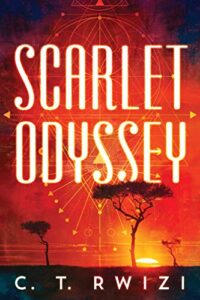Scarlet Odyssey by C.T. Rwizi ( Amazon.com )
47North, 2020
ISBN-13: 978-1542023825
Available: Hardcover, paperback, Kindle edition, audiobook
C.T. Rwizi is a South African author who has drawn from African mythology and landscapes as well as more common fantasy and science fiction tropes to create a unique but recognizable epic fantasy that goes to some very dark places.
In the Red Wilds, among the people of the Yerezi Plains, gender roles are very rigid: men become warriors and hunters, and women become scholars and mystics. Salo is the exception. Before she died, his mother, a mystic, left him the tools to become a powerful mystic himself, but he has kept his talent hidden. Then his clan is attacked by a dark witch, the Maidservant, and her soldiers, killing many of his clan.
The Maidservant is compelled by a curse to serve Dark Sun, a warlord with ambitions to conquer all of the Redlands, but she has plans of her own. The Maidservant’s magic is fed by agony, blood, and hatred stemming from a similar attack on her own village in nearby Umadiland many years ago. Now she is forced to repeat the actions which drove her to revenge.
After the attack, in an effort to save what remains of his clan, Salo asks to be recognized as his clan’s mystic. When he claims his mystic power, the men of his clan feel betrayed. The queen of the Yerezi Plains decides it is too difficult for Salo to remain and sends him on a diplomatic mission to the faraway city of Yonte Saire (I received an ARC of this book and it did not have a map, which seems like a major omission for a story so geographically oriented, so I hope one was included in the final version).
The strict gender roles are also the reason Ilapra left the Yerezi Plains for nearby Umadiland. Her ability and desire to be a fighter was dismissed because she is a woman. As a paid guard and soldier, she has found herself on ethically shaky ground. Salo, traveling alone, hires her to be his guardian. The two join forces with Tuk, an atmech, part machine and part human, created in the more technologically advanced Empire of Light by a necromancer. Appearing and acting just as human as Salo and Ilapra, but with advanced abilities in language and weaponry, Tuk tells them he is traveling to discover the Redlands, which are mostly unknown in the Empire of Light.
Isa is the last member of the ruling family of the Kingdom of Yontai, the Saires, who were murdered in a bloody massacre by possessed soldiers. She has sought sanctuary in the temple while she solidifies her position and decides what her options are, as the head of the Crocodile clan has himself named prince regent. She does not know Salo is coming or that he is unaware that the political situation he’s walking into has changed.
The Enchantress is a mystic who has some kind of plan to destabilize the Kingdom of Yontai both economically and politically. It’s not totally clear what her agenda is, but she is ruthless.
The book’s storytelling alternates between these five point of view characters. A big chunk of the front end of the story involves Salo’s character development and world-building before he sets off on his journey to Yonte Saire, and the backstory of the Maidservant. It is mostly long and slow, partly because Salo, Tuk, and Ilapra are on a long, slow journey. However, Salo is being tracked by the followers of Dark Sun, including the Maidservant, who recognize that he has a unique talent and must be eliminated for Dark Sun to continue his conquest, so the story is broken up with solid action sequences involving impressive magic and considerable bloodshed. The limited technology means communication over long distances is difficult and uncommon, so the Yerezi queen, the Maidservant, and Salo and his friends don’t know what’s really going on in Yonte Saire.
Probably the most successful thing Rwizi accomplished character-wise was to give dimension to the Maidservant. It would be easy to make her a one-dimensional, evil character, but instead she is an example of what trauma can do, passed on to traumatize and victimize others who are in the same situation she was in. There is graphic violence and gore in the book- Rwizi’s black witches really are stained black.
The world building is impressive, and it’s interesting to see how the characters’ worlds widen as they travel. I think we will see this story spreading out onto a larger canvas regarding magic, technology, what constitutes civilization and power, and (possibly) climate change. I also suspect there will be a return to the Yerezi Plains as Rwizi left a number of loose ends.
Because this is a first book and the world building doesn’t have European fantasy tropes to fall back on, Scarlet Odyssey is long, but it isn’t entirely satisfying, because despite its length it ends just as the characters all finally began to come together. It feels like the story is finally picking up the pace and getting going… and then it’s done. Still, it’s a fine beginning to what looks to be an ambitious piece of African speculative fiction. Rwizi is a strong writer who does a good job establishing setting, developing characters, and creating some truly disturbing action scenes. I look forward to his next, hopefully faster-moving, volume in this series. Recommended for adult readers and older teens with strong stomachs.
Contains: large-scale murder, violence, gore, slavery.







Follow Us!